Easy ways to use technology to enhance your effectiveness
By Philip Copeland, Choral Conductor and Teacher
The internet is now an important part of nearly every aspect of our lives; it is present in every business transaction, workflow product, and social engagement. With every new smartphone created and text message delivered, we are becoming more interconnected and as well as more dependent on electronic devices and internet connections.
Most choral musicians have embraced some form of technology. Some dabble in internet news and connect with friends and family with Facebook while others are immersed in a variety of technologies and applications on smartphones, tablet devices, and notebook computers. Likewise, our choir members are often engrossed in technology and we have difficulty when we try to disengage them from their cellphones in our rehearsals.
This article is meant to increase your effectiveness as a leader of an organization and teach you how you can take advantage of the latest developments in technology in order to do your jobs more easily, more effectively, and more efficiently. Five well known tools are covered: YouTube, Twitter, Evernote, Facebook, and EventBrite.
YouTube (www.youtube.com)
By any measure, YouTube is one of the most popular sites on the internet. It has over a billion active users and it can be navigated in seventy-six different languages. Choral music abounds on YouTube and it spans most every composer, genre, and language.
YouTube is developing into a major performance venue for all performers of choral music. Eric Whitacre was one of the first to take advantage of YouTube and its unique capacity to reach the world with choral music. With his VirtualChoir performances, he has reached millions of audience members, including nearly five million views of Lux Aurumque, his first VirtualChoir experiment.
In the same manner, conductors around the world are making careful video recordings of their performances and finding a much larger audience than those who were in attendance at the actual live performance. In some cases, conductors are designing performances explicitly for their YouTube audience.
Gary Weidenaar at Central Washington University was one of the first to have this kind of dedicated YouTube performance. I first discovered Gary and his choir on YouTube performing Claudio Monteverdi’s “Sestina,” a moving work that demonstrated the strengths of his choir and his interpretative skills (You can see a picture of this video in Example 1). Weidenaar’s efforts of YouTube programming pay off in rehearsals. “As we get closer to the recording date, knowing they might be seen by anyone from anywhere changes the dynamic of our rehearsals. We become more focused and purposeful.”
Each video Weidenaar produces is a serious process. He uses five or six cameras for each video, a process that requires a tremendous amount of subsequent time in the editing process. It is the video that requires the editing for Weidenaar; the audio is never altered. If viewership is an indicator of success, the projects seem to be worth it; some videos have over 300,000 views.
Many conductors fear legal issues surrounding YouTube. Our publishing and copyright laws continue to compromise choral directors in this area; we need a way to legally put our performances online. Hopefully, music publishing companies will respond to this need and create a YouTube performance license that is priced at an affordable level for most choirs and conductors.
Twitter (www.twitter.com)
Twitter is a well-known but poorly-understood technological tool. Because each “tweet” is limited to 140 characters, it seems to be of little value. With a little understanding and creativity, however, choral conductors can use the service to benefit their choral program in a number of ways.
First, twitter is free to all and available to everyone. You might ask your friends and followers to “follow” you on twitter and then use the service to publicize concerts, fundraising projects, and other matters of interest. Most choral conductors use Twitter for this purpose.
With Twitter, you can communicate instantly to your choir. It is possible for people to subscribe to twitter posts with their cell phones. To subscribe, a person texts the message “Follow name of twitter account” on to the number 40404. Once the cell phone user has done that, they will receive future “tweets” as text messages.
In Example 2, I have included an example of how you would follow the Samford Choirs twitter account. To stop following an account, just substitute the word “unfollow” for “follow” and you no longer receive text messages from the twitter account.
This texting process is an ideal way for a choral conductor to send messages to the choir about reminders or last minute messages. My last several tweets to my choir include:
- Need someone to pick up programs. Who can do?
- Your presence is required at this very moment. Hodges. Pronto.
- Get here. You are late.
(you can check out more of my messages by looking up our twitter account @SamfordChoirs)
With pictures, a twitter account has the potential to convey a large amount of information. Recently, my choir was scheduled to perform at a campus event called a “Chalk Talk,” a Christmas production where the choir sang about twenty minutes of music while an artist created a chalk drawing. At first, I worried about creating programs for the 500-member audience or talk about the texts and translations of the works we would perform. At the last minute, I realized that I could use Twitter to replace the concert program. Here is what I did:
- First, I created a Twitter account called SamfordChalkTalk.
- Next, I typed up the program of the works we would be performing (in Evernote) and taking a screen shot of it (with a free program called Skitch).
- I “tweeted” the screen shot of the program.
- Next, I found the text and translation of each of the works that I was performing and took screen shots of them using the same process.
In the five minutes before the concert was to begin, we asked the audience to use their smartphones to access the program on Twitter. By using Twitter, we were able to get the information in the hands of our audience without printing a program. (see Example 3)
Evernote (www.evernote.com)
Evernote does a tremendous job at helping users manage their responsibilities and interests. Marketed as a tool that helps you “remember everything,” Evernote can assist you in managing a myriad of information in a number of ways, including typing notes, creating audio files, taking pictures, internet web clipping, forwarding emails, and scanning.
The program is available on most of the digital platforms that you own or use. Desktop applications are complemented with versions for tablets and smartphones. All of the Evernote applications sync with each other, creating an almost seamless experience of information creation and retrieval from one platform to another.
One of the greatest and least used features of Evernote is the ability to share notebooks with public and private audiences. It is a powerful feature and it enables the owner of the notebook to share a vast amount of information; it is perfect for a choir.
I create an Evernote notebook for my choir every year and share it with them by emailing them a link. Once they have the initial link, I can continually add, delete, and update the information in the notebook. Some of the information I share in the notebook includes:
- Calendar for the year and potential calendar for the following year
- Texts and translations of choral music
- Concert planning, directions
- PDF’s of handbooks, music, programs
- Choir rosters
- Rehearsal plans
- recordings, part help, language recordings
In Example 4, you can see the types of information that I share in Evernote. On the left hand column are individual notes, and I have a variety of information for them: international tour planning, programming for two Vesper services, an excuse for other professors, calendars for the year, and how I want the group to divide. In the right pane is the full note, where I have a blank document-type area where I can insert recordings, videos, pictures, and tables of information.
Facebook (www.facebook.com)
With over one billion daily users, Facebook is an internet phenomenon and quite worthy of a choral directors attention. Thousands of choral directors have a personal Facebook profile and so do their choirs. These choirs use Facebook as a way to promote their activities, recruiting drives, and concerts.
To promote your group and concerts, give attention to the following promotion strategies. First, post often and use a lot of pictures and videos. While blocks of text are good for communicating information about your concert, it is the picture that catches everyone’s attention and imagination.
Creating an event in Facebook is easy. Facebook walks you through the basics about time, place, and directions, shown here in Example 5. You can even add a special event photo to coordinate with the event. Once you have developed the basic information about your concert, encourage your members to spread the message and invite their friends. It works, and can build attendance at your concert.
YouTube and Twitter can both be used with Facebook; you can “tweet” about your Facebook posts and feature your YouTube videos on your Facebook page.
EventBrite (www.eventbrite.com)
EventBrite is an online platform that allows choir directors to plan, promote, and sell tickets to their concerts. Once an event is created, it can be promoted on Facebook and Twitter. If your concert is free, there is no charge for the service. If your concert is ticketed, the company charges a fee of 99 cents per ticket and 2.5% of the ticket price.
There are several benefits to using Eventbrite. One of the attractive features is the ability to create and send invitations to your concert. The service also publicizes your concert online and helps your event to show up in a Google search.
For paid concerts, Eventbrite provides a way for an audience to pay with credit and debit cards online prior to the concert or at the door. Concert planners can choose to either absorb the processing fee or pass it along to their audience (see Example 6).
It is free to set up an account with Eventbrite; the interface is clean and the platform coordinates well with Facebook and Twitter.
Conclusion
Technology is available to assist the 21st century conductor in most every issue involving organization, promotion, and communication. If you find yourself confused by any of these tools, ask one of the digital natives to help; they can assist you in learning the basics and may even take on a few of the tasks. With some practice and a little perseverance, you will find that tools of technology have the potential to make you a more efficient and more effective conductors.


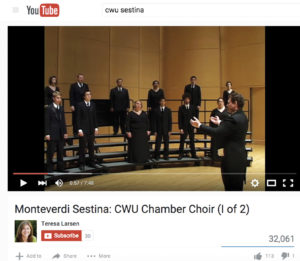
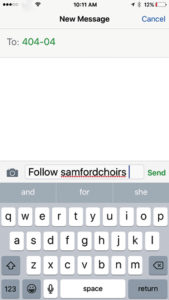
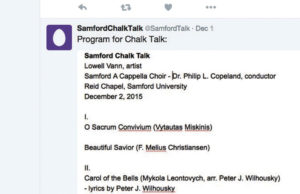
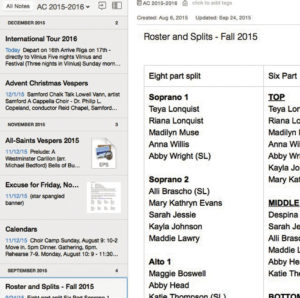
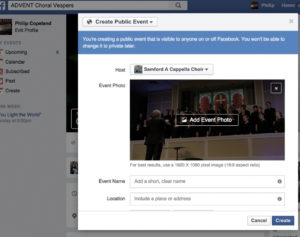
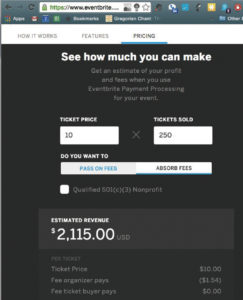
Great ideas! These days there are also choral-specific programs that can do all of these things for you in one place. Groupanizer is a great option for this, for those who want the convenience of it in one spot, and with roles that allow different members of your choir to do different jobs. Check it out! (and yeah, I work there and love it! 🙂
Cheers,
Kari